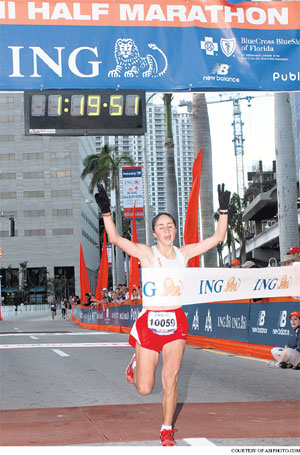[한글 번역] In Running, Some Prefer Just a Half To the Whole

The popularity of the half-marathon (21.1 kilometers) has grown in the last few years. Alicia Cevallos won the 2006 ING Miami Half Marathon.
By JOHN HANCWhat comes after a marathon boom- Perhaps a half-marathon boom.
Half-marathons - races of 21.1 kilometers, or 13.1 miles - have been growing in the last five years, partly due to an influx of newer runners who consider the half a friendlier challenge than the marathon. Half-marathon training is neither as hard nor as all-consuming as marathon training can be.
But those in the running community say there is another reason the distance is catching on: veteran runners who completed multiple quests for marathon glory no longer see 13.1 miles as just a pointalong the journey.“A lot of people have checked the marathon off their ‘life list,’” said Ryan Lamppa, a spokesman for Running USA, a nonprofit organization in Santa Barbara, California, that tracks trends in running. “But they don’t want running out of their lives.”
According to Running USA, the halfmarathon is the sport’s fastest-growing distance . In 2007, there were more than 500 half-marathon events and an estimated 650,000 finishers, a 10 percent increase from 2006. It was the second consecutive year that the number of finishers and events increased by 10 percent .
Clearly, what makes the half-marathon attractive is that it takes a lot less time and energy than a full. Even with the less-ismore marathon programs now in vogue, participants still need to build up to long conditioning runs of at least 32 kilometers before tackling the 42.2-kilometer marathon distance on race day. A half-marathon, by contrast, can be completed by most people with a weekly long run of no more than 17 or 18 kilometers.
“The half-marathon gives you almost all of the satisfaction and achievement of the marathon and far less than half of the aches and pains and fatigue,” said Jeff Galloway, a 1972 Olympian who is now a popular marathon coach and the author of a best-selling book on running.
Linda Ottaviano of Cold Spring Harbor, New York, started running in the early 1990s to help her get in shape; along the way, she became taken with the mystique of the marathon. Over a decade, she finished 12 marathons, the last when she was 50, and completed the 2005 Steamtown Marathon in Scranton, Pennsylvania, in just under 3 hours, 30 minutes.
When she crossed the finish line, she decided she was finished with marathons. “I felt I had accomplished what I had set out to,” she said. And, “I was starting to wonder just how good it was for my body.”
The name has been an issue - running “half” of something doesn’t sound too impressive.
When the US Road Sports & Entertainment Group, a Dallas company that produces endurance events, announced a series of 21.1-kilometer (13.1-mile) races, the words “half marathon” were conspicuously absent. Instead, the series - which starts in Fort Lauderdale, Florida, on November 16 - is called “13.1 Marathon.”
Robert Pozo, the executive director for the series, and his colleagues have even come up with an informal slogan: “13.1 Miles: It isn’t half of anything.”
달리기에서 어떤 사람들은 전체보다 반을 좋아한다
마라톤의 붐 다음에는 무엇이 올까? 아마도 해프 마라톤 붐일 것이다.
21.1킬로미터 혹은 13.1마일을 달리는 해프 마라톤은 지난 5년간 꾸준히 증가해 왔는데 그 부분적인 이유는 해프가 풀마라톤보다 좀 더 친절한 도전이라고 여기는 신참 주자들의 유입 덕분이다. 해프 마라톤 훈련은 마라톤 훈련만큼 어렵거나 모든 것을 소진하는 것은 아니기 때문이다.
그러나 달리기 커뮤니티의 사람들은 그 거리가 인기를 끄는 또 다른 이유가 있다고 말한다. 이미 여러 번 마라톤의 영광의 추구를 끝낸 베테런 러너들이 이제는 더 이상 13.1마일을 마라톤 여정을 따라가는 한 지점으로만 보지 않는 것이다. “많은 사람들이 마라톤을 그들의 ‘삶의 리스트’에서 빼버렸지요”라고 캘리포니아 샌타바바라의 달리기 트렌드를 조사하는 비영리단체 러닝 USA의 대변인 라이언 램파는 말했다. “그러나 그들이 인생에서 달리기를 빼버리기를 원하는 것은 아닙니다”
러닝 USA에 따르면 해프 마라톤은 스포츠에서 가장 빠르게 성장하는 거리다. 2007년에 500개 이상의 해프 마라톤 행사가 열렸고 대략 65만명이 경주를 끝냈는데 이것은 2006년보다 10% 늘어난 수치다. 경주를 끝낸 사람과 행사의 숫자가 2년 연속해서 10% 증가한 것이다.
분명히 해프 마라톤을 매력적으로 만드는 것은 풀보다 시간과 에너지가 훨씬 적게 든다는 것이다. 심지어 요즘은 적은 게 더 좋다는 마라톤 프로그램이 유행이지만 아직도 참가자들은 경주 당일 42.2킬로미터의 마라톤을 뛰기 전에 적어도 32킬로미터는 달리는 컨디션 조절을 오랫동안 단련해야 한다. 이와 대조적으로 해프 마라톤은 대부분의 사람들이 매주 17 혹은 18킬로미터를 넘지 않는 달리기로 끝낼 수 있다.
“해프 마라톤은 풀 마라톤의 만족감과 성취감을 거의 전부 느끼게 해주면서 통증과 고통과 피로감은 절반도 훨씬 안 된다”고 72년 올림픽 마라톤 출신으로 현재 유명 마라톤 코치이자 달리기에 관한 베스트셀러 저자인 제프 갤러웨이는 말했다.
뉴욕 콜드 스프링 하버에 사는 린다 오타비아노는 1990년대 초반 몸매를 날씬하게 하기 위해 달리기를 시작했다: 도중에 그녀는 마라톤의 신비감에 붙잡혔다. 10년 넘게 그녀는 마라톤 12회를 완주했으며 마지막 완주는 그녀가 50세 때 펜실베니아 스크랜턴에서 열린 2005 스팀타운 마라톤에서 3시간30분 바로 밑이었다.
결승라인을 넘어섰을 때 그녀는 마라톤과 끝났다고 결정했다. “내가 세웠던 목적을 달성했다고 느꼈어요”라고 그녀는 말했다. “이제는 그것이 나의 몸에 얼마나 좋은 것인지 의심을 갖기 시작했습니다”
명칭이 이슈가 되어왔다-무엇인가의 ‘반’을 달리는 것은 그다지 멋있게 들리지 않기 때문이다.
인내력 경기를 개최하는 댈러스의 회사 US 로드 스포츠 & 엔터테인먼트 그룹은 21.1킬로미터(13.1마일) 경주 시리즈를 선언함으로써 ‘해프 마라톤’이란 단어를 눈에 띄게 빼버렸다. 그 대신에 11월16일 플로리다 주 포트 로더데일에서 시작되는 그 시리즈는 ‘13.1 마라톤’이라고 불린다.
경주 시리즈의 전무이사 로버트 포조와 그의 회사 동료들은 심지어 다음과 같은 비공식 슬로건도 내걸었다. “13.1 마일: 그것은 어느 것에도 반이 아니다”
존 행크 기자
courtesy of asiphoto.com
어휘 해설
catch on/ 인기를 얻다, 유행하다
second consecutive year/ 2년 연속해서
in vogue/ 유행하는, 인기 있는
less is more/ 적은 게 더 좋다, 적을수록 좋다
conditioning/ (공기의) 조절(=air ~), (심신의) 조절, 컨디션 조절
conspicuously/ 유난히, 눈에 띄게, 유달리
executive director/ 전무이사, 상무이사
스마터리빙
more [ 건강]
[ 건강]이제 혈관 건강도 챙기자!
[현대해운]우리 눈에 보이지 않기 때문에 혈관 건강을 챙기는 것은 결코 쉽지 않은데요. 여러분은 혈관 건강을 유지하기 위해 어떤 노력을 하시나요?
 [ 건강]
[ 건강]내 몸이 건강해지는 과일궁합
 [ 라이프]
[ 라이프]벌레야 물럿거라! 천연 해충제 만들기
 [ 건강]
[ 건강]혈압 낮추는데 좋은 식품
[현대해운]혈관 건강은 주로 노화가 진행되면서 지켜야 할 문제라고 인식되어 왔습니다. 최근 생활 패턴과 식생활의 변화로 혈관의 노화 진행이 빨라지고
사람·사람들
more
“취미생활로 다진 친목… 선후배들과 만든 모교사랑”
사진러브한인 사진 동호회 사진러브(회장 크리스 고)는 13일 용수산에서 송년모임을 갖고 한 해를 마무리하는 뜻깊은 시간을 가졌다. 이날 모임에…

[홀인원] 이상원 박사
일반외과 전문의 이상원(왼쪽) 박사가 지난 9일 뉴포트비치 소재 골프장 9번 홀(152야드)에서 레스큐 클럽으로 친 샷이 그대로 홀에 빨려 들…
[송년행사 게시판] 재미시인협회
재미시인협회(회장 지성심)는 오는 20일 오후 4시 가든스윗호텔에서 한 해를 마무리하며 동인지 ‘외지’ 제35집 출판 기념회와 ‘제23회 재미…
[송년행사 게시판] 향군단체 연합
6.25 참전유공자회와 대한민국 육군협회 등 남가주 지역 향군 단체 연합은 19일 오전 11시30분, 용궁에서 송년 행사를 개최한다. 드레스코…
[송년행사 화보] “이웃과 함께 나누고 지인과 함…
KYCC13일 윌튼 플레이스 초등학교에서 열린 ‘한인타운청소년회관(KYCC) 홀리데이 카니발’이 성황리에 막을 내렸다. 올해는 KYCC 창립 …
많이 본 기사
- ‘유세방불’ 트럼프 “관세가 물가 올린다더니 인플레 수년來 최저”
- 30년 만에 ‘금리 0.5%’ 허문 일본
- 이 대통령 “피도 눈물도 없는 금융사… 공적 책임의식 충분한가”
- 대북제재 완화 시그널… 이 대통령, 통일부 역할 주문
- 이 대통령, “불법촬영물, 초국가 범죄 대응본부 수사”
- 개명 하루만에 케네디센터 외벽에 ‘트럼프’ 추가…위법 논란도
- 신민아♥김우빈, 결혼식 날 웨딩 사진 첫 공개..눈부신 투샷
- 대법 예규 후속절차, 22일 ‘형사부 증설’ 판사회의… 서울고법 ‘내란 전담재판부’ 설치 돌입
- 오바마케어 보조 확대 연장 종료 유력
- “루비랑 데이트”..송혜교의 따뜻한 연말
- 뉴욕-뉴저지 다리· 터널 통행료 또 오른다
- 시민권 박탈 착수⋯매달 200명 1
- 뉴욕주 차량운전자 벌점 규정 대폭 강화
- 금리 인상 ‘엔 캐리(싼 이자로 엔화 빌려 투자)’ 빠져나갈라… 비트코인·환율 ‘출렁’
- ‘80세’ 선우용여, 대세 유튜브 수… 1
- 故윤석화 빈소에 추모 발길… “하늘에서 좋은 작품 많이 하기를”
- 북한군, 지난달 MDL 10번 넘었다
- “개인 부동산 취득, 법카 사적 유용” 박수홍 친형 구속 이유 보니
- 트럼프, 화성은 미루고 달부터…머스크… 2
- ‘김혜성도 넘었다’ 6년 120억 결… 1
- 각국 AI 패권 경쟁 본격화… 5조달러 시장 선점 총력
- 법무부, ‘엡스타인문건’ 공개…정재계 추가 연루 증거 나올까
- 동업자에서 채무자로..MC몽, 차가원… 1
- [삶과 생각] “재미있게 묘사한 오늘날 우리의 삶”
- “불공정 행위 걸리면 망하게 대기업 과징금 세게 때려야”
- “박나래, 주사 이모 약에 내성 생겨..약 떨어지면 연락하라고”
- 尹 소환한 김건희특검, ‘명태균 의혹’부터 6가지 혐의 순차 추궁
- 고환율, 생산자 물가 석달째 오름세
- 美, IS 무기고 등 70여곳 공습… “전쟁 시작 아닌 복수 선언”
- [업계] 12월 내내 크리스마스 특별 메뉴 출시
- 구글, 검색결과 크롤링 업체 상대 소송…AI 경쟁사 견제 의도
- [사는 이야기] 요즘 한국은
- 기아 미국법인, 2026년형 ‘K4 … 1
- 아마존, 칩 조직 통합 개발사 본격 변신 포석
- [정지원 법률 칼럼] 겨울철 낙상사고(주택)
- AMRO(아세안+3 거시경제조사기구) “한국 경제 개선세” 내년 1.9% 성장 예상
- 해군, 트럼프 ‘황금함대’ 새 전함 발주… “외국조선사도 활용”
- 에이미 리씨 유튜브 영상 ‘신데렐라의 꿈’ 화제
- 파워볼 1등 잭팟 15억 달러로 치솟아
- 尹, 김건희특검 첫 출석…변호인 “아내 금품수수 몰랐다”
- “트럼프, 강경화 대사에 ‘李대통령과 최고의 협력관계’ 언급”
- “AI 보안으로 클라우드 시장 잡자”…구글, 100억 달러 보안 파트너십
- 김민선 백악관 자문위원 백악관 연말 파티 참석
- 퀸즈장로교회 ‘사랑의 바구니’130개 이웃에 전달
- [새해부터 이렇게 달라진다] 최저임금 또 오르고… 유급 병가는 더 확대
- 브라운대 총격 용의자 시신 발견… ‘… 1
- 美, 베네수 마두로 압박 강화…처제·동서·조카 무더기 제재
- 장애인 예술단체 ‘리디스커버 아티스트’ 그룹전
- “스페이스X, 상장 주관사 선정 착수…모건스탠리 유력”
- 中, ‘트럼프와 합의’ 美대두 수입 … 1
1/5지식톡

-
 ☝️해외에서도 가능한 한국어 선생님…
0
☝️해외에서도 가능한 한국어 선생님…
0이 영상 하나면 충분합니다!♥️상담신청문의♥️☝️ 문의 폭주로 '선착순 상담'만 진행합니다.☎️ : 02-6213-9094✨카카오톡ID : @GOODEDU77 (@골뱅이 꼭 붙여주셔야합니다…
-
 테슬라 자동차 시트커버 장착
0
테슬라 자동차 시트커버 장착
0테슬라 시트커버, 사놓고 아직 못 씌우셨죠?장착이 생각보다 쉽지 않습니다.20년 경력 전문가에게 맡기세요 — 깔끔하고 딱 맞게 장착해드립니다!장착비용:앞좌석: $40뒷좌석: $60앞·뒷좌석 …
-
 식당용 부탄가스
0
식당용 부탄가스
0식당용 부탄가스 홀세일 합니다 로스앤젤레스 다운타운 픽업 가능 안녕 하세요?강아지 & 고양이 모든 애완동물 / 반려동물 식품 & 모든 애완동물/반려동물 관련 제품들 전문적으로 홀세일/취급하는 회사 입니다 100% …
-
 ACSL 국제 컴퓨터 과학 대회, …
0
ACSL 국제 컴퓨터 과학 대회, …
0웹사이트 : www.eduspot.co.kr 카카오톡 상담하기 : https://pf.kakao.com/_BEQWxb블로그 : https://blog.naver.com/eduspotmain안녕하세요, 에듀스팟입니다…
-
 바디프렌드 안마의자 창고 리퍼브 세…
0
바디프렌드 안마의자 창고 리퍼브 세…
0거의 새제품급 리퍼브 안마의자 대방출 한다고 합니다!8월 23일(토)…24일(일) 단 이틀!특가 판매가Famille: $500 ~ $1,000Falcon: $1,500 ~ $2,500픽업 & 배송직접 픽업 가능LA…
케이타운 1번가
오피니언
 한영일 / 서울경제 논설위원
한영일 / 서울경제 논설위원[만화경] 웰다잉 인센티브
 캐슬린 파커 워싱턴포스트 칼럼니스트
캐슬린 파커 워싱턴포스트 칼럼니스트 [캐슬린 파커 칼럼] 아이들을 온라인에서 보호하기
 양상훈 수필가ㆍ시인
양상훈 수필가ㆍ시인 [한국춘추] 경제대공황ㆍ제2차 세계대전 승리로 극복한 루스벨트 리더쉽

[왈가 왈부] 고환율에 외환 건전성 완화·서학개미 규제… 미봉책 아닌가요
 수잔 최 한미가정상담소 이사장 가정법 전문 변호사
수잔 최 한미가정상담소 이사장 가정법 전문 변호사 [수잔 최 변호사의 LIFE &] AI 시대 편리함에 안주하지 말자
 김도년 성균관대 건축학과 교수 스마트도시·건축학회장
김도년 성균관대 건축학과 교수 스마트도시·건축학회장 [로터리] 지멘스가 만드는 미래 동네
1/3지사별 뉴스

퀸즈장로교회 ‘사랑의 바구니’130개 이웃에 전달
퀸즈장로교회가 18일 크리스마스를 앞두고 교인들의 정성과 사랑이 듬뿍 담긴 ‘사랑의 바구니’ 130개를 소방서와 경찰서, 요양원, 선교회, 그…
시민권 박탈 착수⋯매달 200명

“이웃 돌보는 여러분이 동역자”
워싱턴성광교회(담임목사 임용우)는 18일 한인단체와 소방서‧도서관 등에 총 2만9천 달러의 성금을 전달했다. 지난 2011년부터 15년째 지역…
소기업 지원에 1천만 달러 투자

위기의 트럼프 “내년봄 최대규모 세금환급”
트럼프 대통령은 17일 “취임 1년 만에 우리는 누구도 상상하지 못한 성과를 이뤄냈다”고 말했다.트럼프 대통령은 동부시간 이날 밤 9시부터 백…
[새해부터 이렇게 달라진다] 최저임금 또 오르고… 유급 병가는 더 확대

오늘 하루 이 창 열지 않음 닫기 




















































.png)


댓글 안에 당신의 성숙함도 담아 주세요.
'오늘의 한마디'는 기사에 대하여 자신의 생각을 말하고 남의 생각을 들으며 서로 다양한 의견을 나누는 공간입니다. 그러나 간혹 불건전한 내용을 올리시는 분들이 계셔서 건전한 인터넷문화 정착을 위해 아래와 같은 운영원칙을 적용합니다.
자체 모니터링을 통해 아래에 해당하는 내용이 포함된 댓글이 발견되면 예고없이 삭제 조치를 하겠습니다.
불건전한 댓글을 올리거나, 이름에 비속어 및 상대방의 불쾌감을 주는 단어를 사용, 유명인 또는 특정 일반인을 사칭하는 경우 이용에 대한 차단 제재를 받을 수 있습니다. 차단될 경우, 일주일간 댓글을 달수 없게 됩니다.
명예훼손, 개인정보 유출, 욕설 등 법률에 위반되는 댓글은 관계 법령에 의거 민형사상 처벌을 받을 수 있으니 이용에 주의를 부탁드립니다.
Close
x